In 1901, the year Queen Victoria died, a certain Frank Hornby (1863-1936) created a toy company called Meccano, but his most famous creation was in 1920, when he began making toy trains, and used his own name for the brand. The company thrived before the Second World War, and for a few years after, but were in serious trouble by the late 1950s. Meanwhile, a company called Rovex Models was created in the late 1940s, and was bought by Lines Bros in 1951 when they started making model railways. These were quickly rebadged under the brand name Tri-ang, and this new company also prospered, such that in 1964 they bought the ailing Meccano, including the Hornby brand. From that date the Hornby and Tri-ang product ranges were combined (though mostly the more modern Tri-ang products survived while the old-fashioned Hornby ones were dropped) under the name Tri-ang Hornby. Lines Bros itself collapsed in 1971, and Tri-ang Hornby was sold on, with the new owners keeping just the Hornby name.
This brand continues to this day, and Hornby remain a major player in the model railway market, but of course our interest is in any figures that they made, which were in OO/HO scale (a little smaller than true 1/72nd, but close enough). In the early days (up to the late 1950s), there were very few figures, and they were metal (made by Dinky, another part of the Meccano Group), crudely painted and in very dull poses. The first plastic figures were made by Tri-ang, and first appeared in their 1962 (8th edition) catalogue. There were three small sets, sold in small poly bags with a cardboard header onto which the name of the set was stamped, as follows:
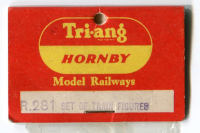
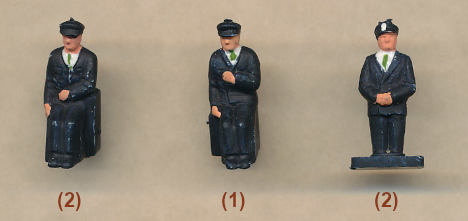
Average Height: 19 mm (without the base) or 20 mm (with the base)
This first set boasts five figures in three poses, described as a driver, fireman, motorman and two guards - we leave it up to you to decide which figure is meant to fulfill which role. These are adequately sculpted in dark blue plastic (also possibly sometimes white), but not helped by a very basic factory paint job where the flesh bits are painted, as are the shirt, a green tie and a cap badge for the guard. The guards have sacrificed their feet, presumably to help ensure the figure with its base can be persuaded to fit into a very small space, but once installed, such niceties as feet may not be visible much anyway. Since everyone has their arms firmly held against their body, these are easy figures to sculpt but with no action about them, so hardly attractive models on their own. However, as a means of showing that trains do not magically run by themselves, especially steam locomotives with empty footplates, these are adequate.
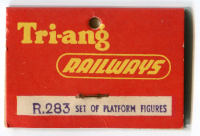

Average Height: 23.5 mm
If your railway has platforms then it will need people, otherwise what is the point of your trains? This set addresses that need by offering a guard, porter, city gent, sitting man and sitting woman. Again the sculpting is fairly basic, and the poses very static, although this is not inappropriate given the subject. The guard wears a double-breasted jacket and a peaked cap, and the porter is smartly turned out in peaked cap and waistcoat, while the city gent, as per the stereotype, wears a suit and bowler hat, and carries an umbrella and a newspaper. The seated man wears a flat cap and a jacket, and the woman a neat suit and small hat. All look very dated by today's standards, as of course they would be, being designed well over half a century ago. All the men wear a tie, and there is not a phone or set of headphones in sight, so not typical of modern rail passengers, but perfectly good for the 1950s or 60s. The factory painting does not improve things, since as always it is rushed and crude, but all these figures were made in a white plastic, so all but the woman need a fair amount of painting. All the figures are okay, but again more of a nod toward the need to populate a railway rather than offering a realistic selection, but better than nothing. Unlike the train figures however, they are a better height for true 1/72 scale.
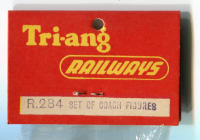
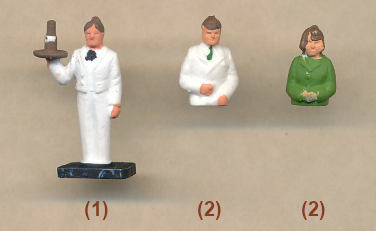
Average Height: 20.5 mm (where legs are included)
Although some modellers are content to have their passenger coaches run around all day without a soul on board, we like to see then actually taking people where they want to go (which admittedly is usually in endless circles), and so we come to the last of the early Tri-ang Railways figure sets. The official description of this set speaks of one attendant, two man 'tops' and two woman 'tops'. Clearly many model carriages have no provision for leg room, so upper-body-only passengers are quite sufficient, and the attendant, while lucky enough to possess legs, has no feet, presumably for the same reason as the train figures above. The attendant carries a tray with a bottle of something on it, and shows remarkable balance given that he is on a train bouncing around. The two passengers are just sitting quietly and looking straight ahead, so again basic but adequate. These figures were moulded in either white, dark blue or black plastic, with flesh, hair and ties painted on, as were the serving tray and bottle. One of the two woman figures was otherwise left unpainted, and so in an outfit of the plastic colour, but the other was apparently always painted with a green top, as shown. Double-breasted jackets must have been the fashion when these sets were produced, because here again the male passenger wears one, and a tie. It was normal back in the 1950s for people to wear their best outfit when travelling, hence the large number of smart jackets and ties. Like the rest of the range, these figures are adequate but uninspiring, but the attendant is a nice touch. However, the science of little plastic passengers for model coaches has moved on a lot since this set was made.
In 1963 a new set was added, this time even smaller than those that had gone before, but certainly one that was needed...
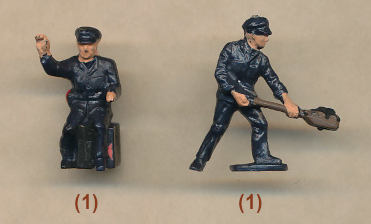
Average Height: 22 mm
Given that Tri-ang had recently made their set of R281 train figures, it seems strange that they would quickly add this new set. The driver figure is a similar pose to that in the older set, except that he has his right arm raised and his left extended forward, so is much more convincing as actually operating a locomotive (though still sitting down). The fireman pose is a big improvement, as this time he is on his feet, shoveling coal. The standard of sculpting is the same as the earlier sets, so adequate rather than great, and the figures were made in a dark blue plastic with painted flesh. Also painted were the fireman's shovel and coal, and something on the right side of the driver which we could not identify, but is painted red. The figures are fairly small, more like true 1/87 scale, but needed to fit into a very confined area most of the time. As always, not great to examine closely, but fine when hidden in the cab of a fast-moving locomotive.
In addition, Tri-ang released a model of Stephenson's Rocket in 1963 which came with its own dedicated crew. The crew were never made available separately, but consisted of the driver and fireman in period costume. These were much more realistically clothed than the Airfix model, since they wear ordinary working men's costume rather than top hats, and are in reasonable poses, with the driver standing holding the controls while the fireman shovels coal. Since they were only ever sold with the locomotive, and this is a rare and expensive item these days, these figures are now extremely hard to find.
The original three Tri-ang figure sets as described above (Train Figures, Platform Figures and Coach Figures) remained available through to the 1971 catalogue, but the following year they were replaced by a single set, R360, named 'Railway Figures Set'. This was a combination of these three sets, and contained 30 figures made up of two copies of each. Unlike the old sets however, now they were provided unpainted, and in a pink plastic. This product remained in the range for three years before these figures were retired permanently.
First appearing in a Tri-ang Railways catalogue in 1964, and intermittently thereafter, there were also six sets of figures marketed under the Tri-ang Railways label as 'Model Land' which were not specific to railways, but more general subjects that might work well on a layout. These were...
RML 70 Pedestrian Figures Set
RML 71 Workmen Figures Set
RML 72 Child Figures Set
RML 73 Urban Figures Set
RML 74 Industrial Workers Set
RML 75 Road Workmen Set
All were labelled as OO/HO scale, factory painted and sold in blister packs. These too are very rare these days, but here is how the sets were presented in the 1970 Tri-ang Hornby catalogue:
Each set of six figures was nicely presented in a blister pack such as this one for the Industrial Workers set:
Note that this set has the incorrect set number printed on the card. Apparently this was a common fault with the earlier production.
The figures themselves are really nice, and the poor photos in the catalogue don't do them justice. Well sculpted on small round bases, the factory painting is relatively good compared to many others. They stand an average of 23 mm tall, so perfect for 1/72 scale. Below is a closer look at the same set of Industrial workers, which are a postman, a milkman, workman with spade, painter with a tin of paint, another painter actually painting, and a woman perhaps cleaning a window. Clearly the label 'industrial' is something of a stretch here, but these are all very useful street scene figures, and nicely presented.

A new range first seen in 1966 was the Tri-ang Hornby Battle Space series, although in truth many of the elements had been available before. However, with this launch came a new set of 'Battle Space Men', also called Battle Space Commandos. Most of the range of vehicles came with a small pack of 'space commandos', usually either six or 12 figures. Below is the image of this range in the 1971 (17th Edition) catalogue, the last in which the range was to appear.
This image shows us the available wagons etc., with a liberal scattering of 'space commandos', and is the only one to show so many. From this and surviving examples of this range, it would appear that there were six poses of soldiers, five of which are shown on this catalogue image, and are also shown in the below enlarged image.
We say there were six because, despite the catalogue image, a sixth pose of a man swinging his rifle with bayonet over his head also seems to have been part of the collection. The full six poses are shown below:
These figures are very like ones made by Blue Box (almost identical, but not quite), and may perhaps have been made by them for Tri-ang? Self-evidently these are really poor sculpts, and a pretty terrible factory paint job only makes matters worse. They are also very much on the large side (28 mm tall on average), especially for railways that claim to be OO gauge (1/76 scale), since at that scale they would all be about 2.13 metres tall (which at the time they were made would have been expressed as almost seven feet tall)! Matters are not helped by the very large, circular 'penny' bases they all have, which is particularly inconvenient if you want to stand them in a confined space on one of the wagons, although they would at least stand pretty reliably on most bedroom carpets.
In the 1960s and 70s, manufacturers regularly copied each other, making it very difficult to be sure which figure is from which source. Many will find the look of these figures very familiar, since they are remarkably similar to the old Crescent figures, and the officer looks like the old Herald/Britains figure (and the early Airfix Infantry Combat Group also has similarities with these).
Those with particularly good eyesight may have noticed that the Tri-ang catalogue is not consistent, and the two non-moveable ground-to-air missile products (bottom right of the page) show rather different figures. It is far from clear whether these figures were actually included in the range - manufacturers often use prototypes when photographing catalogues, but the final product may turn out to be very different. These figures, which are also sometimes sold today on auction sites labelled as 'Tri-ang Space Commandos', look like this:
Some poses are quite similar (there's that officer pose again!), but they are not the same sculpts and are also a bit smaller, so it is very hard to be sure what their source is. Perhaps they were only ever used for the catalogue shoot?
For a few years from 1975 there were no figure sets in the now Hornby catalogue, although the two-man loco crew may have been available as part of certain locomotives. In 1984 Hornby released their set R573 'Locomotive Super Detail Pack', which included some small accessories for your locomotives as well as the same two-man loco crew from R413, but this time unpainted and made in a black plastic. Although it came and went somewhat randomly in the following catalogues, this product was available for many years, and while it does not appear in the current catalogue, new examples are still fairly easy to obtain online.
In 1983, Hornby started to release a completely new range of figures and accessories. As at the time of writing (2025), there are eight titles in this series, and all remain in production to this day. Three of these, R7120 (Farm Animals), R7121 (Cows) and R7122 (Sheep) will not be included here, but we will take a close look at the five sets of people that were produced, the first four in 1983, and the fifth in 1984.
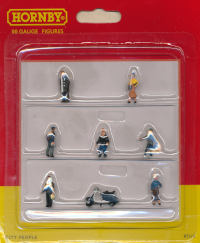

Average Height: 21.5 mm
The first thing that you notice with these figures is that they have no base, and are impossible to make stand. This even applies to the scooter, despite the extra bit between the wheels which we assumed was there to do precisely that. The second thing you notice is these are all made in a very flexible, rubbery plastic, which is really unusual for such things. The factory-applied paint bends equally well, so these will probably take a lot of punishment without showing damage, but the only way they can be deployed is by being glued to either a base or else the final platform or other location. Not only is the material really soft - the detail is too. These are very poorly defined, with virtually no face, no hands and no folds in clothing. This was the biggest surprise of all, considering they were originally made in the 1980s, when far better sculpting was being achieved by other companies. As always, they are intended to decorate a layout where the trains are the centre of attention, so were presumably not designed with close scrutiny like this in mind, yet compared to the output of most other manufacturers, even those making similar products, these are very poor. The range of clothing is reasonable for 1980s civilians, and all are fairly smartly dressed, matching the name of city people, but again they are a little dated as there are no electronic devices as you would expect to see these days on any railway. The man sits on the scooter quite well, and made us think of the same thing in the Airfix Civilians set, although there it was done much better, despite being over 20 years earlier. Perhaps these are adequate for their task, but not something any serious modeller is likely to find appealing.
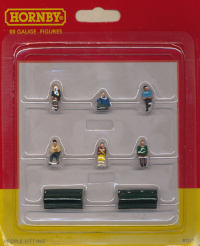

Average Height: 21.0 mm
This collection of sitting people provides just the same as the city people set in terms of quality, a very rubbery plastic, exceptionally basic sculpting and poor factory painting. There are no faces, no hands and absolutely no detail on the clothing, so we find no folds, no fastenings, nothing but a smooth surface regardless of the garment. As a result they look really terrible, and, despite their secondary role on a railway layout, we would have thought they would look pretty bad even in that supporting role. We liked the idea of the first figure, who is sitting in a more casual manner, and the person sitting on the ground, so the poses overall are reasonable given the spec, but you can't escape just how bad they look. The bench seat, which is a double, is simple but reasonable, and we should point out that the set includes two of these (there is just one of each figure), and while also made of the same, highly flexible material, it is about the best thing in this disappointing set.
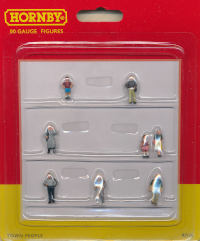

Average Height: 21.0 mm
Here we find a group of men, women and children in rather more casual clothing than those in the city set. Although it is difficult to make out, all apart from the first figure seem to wear normal clothes as might be worn on a warm day, although the first figure wears some sort of long coat with a hood. One woman is walking, and the last man seems to be wearing a tracksuit and is jogging, but otherwise everyone is standing still, so perhaps work better on a platform than in the street. While the poses are exactly as uninteresting as they should be, the key qualities of these figures are the same disappointing ones as in the other sets. Almost no detail means we have no faces, hands or other refinements, and the usual factory rapid paint job does nothing to improve the look. None of the figures stand, having no base, and the ultra-bendy plastic they are made of does not bode well either, although at least there will be no issues with flaking paint. Nevertheless, there are many, far superior products than this which achieve the same thing, and in a much more sturdy plastic, so this set really has little to recommend it.
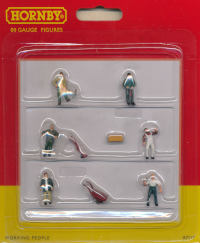


Average Height: 22.0 mm
If you are going to create a scene of urban living, or even just a quiet village, then just having people standing or walking about isn't enough. Adding people who are busy in some task adds realism to any model environment, which is why this set was produced. We find a man with a sack truck and another with a wheelbarrow, while the bottom row houses men using a pick, a drill and a hammer, plus someone carrying a crate on their shoulder. All are reasonable choices, and well posed apart from the man with the drill, which seems much too short for the job and would force him to constantly stoop. Clothing is basic and almost entirely detail free, so it is hard to comment much on that, except to say that this does rather date the set. If these were official workmen, e.g. maintaining infrastructure, then these days we would expect to see high visibility clothing, hard hats, gloves and so on. If they are people just doing jobs in their own garden then that makes more sense, although the driller can hardly be categorised as domestic. The lack of faces and hands make these ugly figures, and the super-soft plastic and lack of bases makes them difficult to handle, like the rest of the series. More modern sets from other manufacturers would be preferable to this one, if you are trying to recreate a very modern landscape, and frankly they would probably be much better quality than these too.
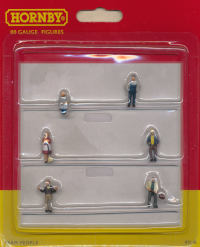

Average Height: 22.0 mm
Any countryside which lines the path of a railway will be made more interesting with some form of agricultural activity in it, and many layouts have at least some form of open fields along their route. A set of agricultural workers makes good sense, but in looking at this collection we were surprised and sometimes mystified by the design choices made. The first man wears work overalls and looks fine, but the second, wearing a short jacket and trilby, does not seem to us like any sort of farm worker we have ever seen. The man to his left is even stranger, wearing a shirt with a yoke rather like some country and western singer, and a yellow blob at his neck (is that a cravat?) - again nothing rural about this figure to our eye. The man with the spade is fine, as is the woman presumably sweeping the yard or something, but the biggest mystery is the last figure. This is sitting (on what?) and wearing a long robe and skull cap. It looks like someone wearing traditional Middle East costume, which cannot have been the intention, so possibly this is meant to be an old person, but whatever the designer had in mind, the sculptor has murdered it in the execution. The poses are mostly inanimate, and for the majority it is hard to imagine them anywhere near a farm. The same soft material is not satisfying, and the lack of bases means they do not stand. The crude paint job matches the crude sculpting, so even if some of the choices were not completely baffling, this is hardly a set that would enhance even the meanest of layouts.
It must be said that railway figures tend to be fairly basic as they are merely populating a large model where the trains are the stars. So when we came to review these Hornby sets, particularly the later ones, our expectations were not high. However we were greatly surprised by how poor they actually were, particularly the lack of any attempt to sculpt basic things like faces and hands. The basic factory painting is to be expected, but we were surprised by the very rubbery material used, although to be fair the review samples were purchased new in 2025, and much older examples may be in a different material. In viewing the long history of Tri-ang and Hornby catalogues, we were struck by the many beautiful scenes of models that they contain, and all have many fine figures to give them life. Unfortunately, none of them are actual Tri-ang Hornby products (we suspect they are from Preiser), which must have been very frustrating for their young customers back in the 60s, 70s and 80s.
In conclusion, the very old figures are basic, as you might expect of figures of this vintage, but the later ones are really ugly, poorly made, and with some incomprehensible design decisions in the farm set. All the figures are small (as they are for OO and HO scales, or need to fit in tight spaces), but really offer nothing to the more general modeller in our view. Comparable products from Bachmann and Dapol, reviewed elsewhere on this site, are of far better quality, and of course the incomparable Preiser range sits above them all, leaving this tiny Hornby range, which shows no sign of being expanded or improved, far, far behind.